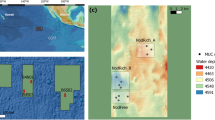Abstract
The search for shelter from predatory and grazing organisms leads to the settlement of sessile benthic deepsea organisms, especially in hollows of manganese nodules. These organisms, mostly foraminifers, grow mainly in narrow fractures, which prevents cracking of the nodule, or they attach their tests at the contact zone between two neighboring nodules, welding them together to form a polynodule. These processes operate very rapidly, probably within days or months. Benthic organisms searching for food are able to move nodules, and they may turn over even large nodules several times. It is assumed that benthic activity is responsible for the lifting of manganese nodules.
Similar content being viewed by others
References
Dugolinsky, B. K., Margolis, St. V., and Dudley, W. C., 1997. Biogenic influence on growth of manganese nodules. Journal of Sedimentary Petrology, v. 47, pp. 428–445.
Burnett, B. R., and Nealson, K. H., 1981. Organic films and microorganisms associated with manganese nodules. Deep-Sea Research, v. 28A, pp. 637–645.
Paul, A. Z., Thorndike, E. M., Sullivan, L. G., Heezen, B. C., and Gerard, R. D., 1978. Observations of the deep-sea floor from 202 days of time-lapse photography. Nature, v. 272, pp. 812–814.
Dugolinsky, B. K., 1976. Theory of formation: life forms on manganese nodules. Ocean Industry, v. 11, pp. 88–90.
Thiel, H., 1978. The faunal environment of manganese nodules and aspects of deep sea time scales. In: W. E. Krumbein (ed.), Environmental Biochemistry and Geomicrobiology, v. 3, Ann Arbor Science, Ann Arbor, Michigan, pp. 887–896.
Halbach, P., and Özkara, M., 1979. Morphological and geochemical classification of deep-sea ferromanganese nodules and its genetical interpretation. Colloques Internationaux du Centre National de la Recherche Scientifique, v. 289, pp. 77–88.
Wo, C. C., 1976. Origin of the surface textures of some manganese nodules from the equatorial North Pacific. Open-tile Report 76-548, U.S. Geological Survey, pp. 217–232.
Margolis, St. V., Dugolinsky, B. K., and Dudley, W. C., 1979. Microchemistry and morphology of biogenic, detrital and authigenic phases in Pacific manganese nodules. Colloques Internationaux du Centre National de la Recherche Scientifique, v. 289, pp. 179–190.
von Stackelberg, U., 1979. Sedimentation, hiatuses and development of manganese nodules: Valdivia site VA-13/2, northern central Pacific. In: J. L. Bischoff and D. Z. Piper (eds.), Marine Geology and Oceanography of the Pacific Manganese Nodule Province. Plenum Press, New York, pp. 559–586.
Piper, D. Z., and Fowler, B., 1980. New constraint on the maintenance of Mn nodules at the sediment surface. Nature v. 286, pp. 880–883.
Calvert, S. E., and Price, N. B., 1977. Geochemical variation in ferromanganese nodules and associated sediments from the Pacific Ocean. Marine Chemistry, v. 5, pp. 43–74.
Raab, W., 1972. Physical and chemical features of Pacific deep sea manganese nodules and their implications to the genesis of nodules. In: D. R. Horn (ed.), Ferromanganese Deposits on the Ocean Floor. National Science Foundation, Washington, pp. 31–49.
Sorem, R. K., Fewkes, R. H., McFarland, W. D., and Reinhart, W. R., 1979. Physical aspects of the growth environment of manganese nodules in the “Horn Region,” East Equatorial Pacific Ocean. Colloques Internationaux du Centre National de la Recherche Scientifique, v. 289, pp. 61–76.
Wendt, J., 1974. Encrusting organisms in deep-sea manganese nodules. Special Publication, International Association of Sedimentologists, v. 1, pp. 437–447.
Gooday, A. J., and Haynes, J. R., 1983. Abyssal foraminifers, including two new genera, encrusting the interior ofBathysiphon rusticus tubes. Deep-Sea Research, v. 30, pp 591–614.
Riemann, F., 1983. Biological aspects of deep-sea manganese nodule formation. Oceanologica Acta, v. 6, pp. 303–311.
Menard, H. W., 1964. Marine Geology of the Pacific. McGraw-Hill, New York, 271 pp.
Heath, G. R., 1978. Deep-sea manganese nodules. Oceanus, v. 21, pp. 60–68.
Glasby, G. P., Stoffers, P., Sioulas, A., Thijssen, T., and Friedrich, G., 1982. Manganese nodule formation in the Pacific Ocean: a general theory. Geo-Marine Letters, v. 2, pp. 47–53.
Author information
Authors and Affiliations
Rights and permissions
About this article
Cite this article
von Stackelberg, U. significance of benthic organisms for the growth and movement of manganese nodules, Equatorial North Pacific. Geo-Marine Letters 4, 37–42 (1984). https://doi.org/10.1007/BF02237972
Received:
Revised:
Issue Date:
DOI: https://doi.org/10.1007/BF02237972




